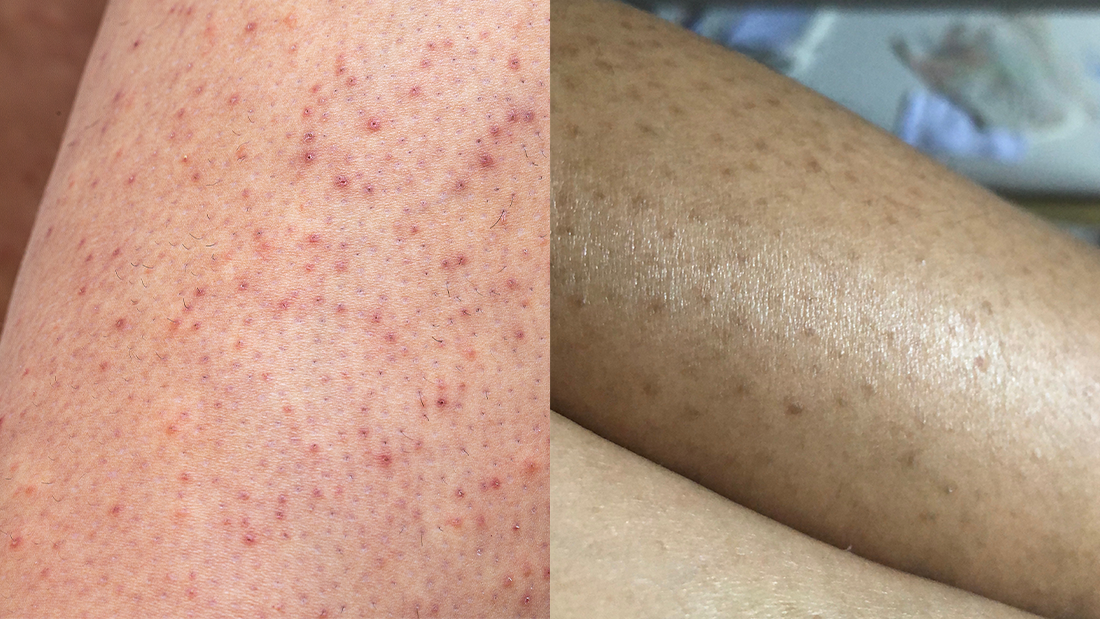If you’ve ever experienced those small, sometimes reddish bumps on your skin, you’re not alone; so-called “chicken skin” is so common it’s often considered a normal variant of human skin. In medical terms, it’s better known as keratosis pilaris (KP) – but what actually is this, and can it be treated?
What is keratosis pilaris?
KP is a harmless skin condition characterized by small, painless bumps on the skin, often found on the upper arms and thighs, but also the face and buttocks. These bumps can sometimes be red or brownish black in appearance depending on skin tone and might be accompanied by dry, rough-feeling skin.

The bumps can look more red in color on paler skin and more brown on deeper skin tones.
Image credit: sruilk/Tai Ketlakorn/Shutterstock.com; modified by IFLScience
For some people with this condition, it can get worse during the winter, whilst others might experience itching that can also worsen at this time.
There’s not a strict diagnostic test for KP, but doctors are usually able to diagnose it based on whether a person’s skin matches up with the features above.
How common is it?
If you’ve never had it yourself, chances are you know someone who has had it or still does. KP is thought to affect anywhere from 50 to 70 percent of teenagers – it often first appears during early childhood or as a teen – and around 40 percent of adults.
What causes it?
There’s a clue as to what causes KP in its name. “Keratosis” refers to when an excess of the protein keratin in the outermost layer of the skin causes “horny growths” – in the case of KP, small bumps.
The buildup of keratin – which provides structural support to the skin – in KP occurs in the hair follicles, hence “pilaris” stems from the Latin term for hair, “pilus”.
Under normal circumstances, keratin is sloughed off, but what exactly leads instead to the accumulation of keratin is unclear.
KP is not contagious, so you can’t catch it from other people. There are some known factors that can increase someone’s risk of developing KP:
- Having family members who have KP
- Other skin conditions such as dry skin, atopic eczema, or a rare condition known as ichthyosis vulgaris
- Asthma or hay fever
- Excess body weight
The fact that KP often runs in families indicates to scientists that there could be a genetic root to the condition. A good place to start is by looking at the genetics of conditions often associated with KP and this has primarily focused on ichthyosis vulgaris – which manifests as extremely dry, scaly skin – and atopic eczema.
This led scientists to mutations in the gene (FLG) encoding filaggrin. This is a protein that, under normal circumstances, binds to fibers of keratin and helps to maintain the skin’s barrier. Changes to FLG have been associated with KP, though the pathways by which these mutations lead to keratin buildup are not yet established.
Though a positive step, the search for a cause is far from over, and not just limited to FLG. Some scientists suggest that FLG mutations can’t account for all of the observable traits of KP, nor for the differences in those traits seen between people. In support of that, a small study of 20 people with KP found that only 35 percent had FLG mutations, although they note this is higher than the average European carrier frequency of 4 to 9 percent.
Are there treatments for keratosis pilaris?
KP doesn’t have a cure, but for many people, it clears up during adulthood. As mentioned, it’s also a harmless condition, so it doesn’t need to be treated unless someone wishes it to be. In such cases, some things can help to reduce the dryness or change the appearance of the bumps – though it should be noted that none are guaranteed to do so quickly.
Which treatment is used depends on what feature of KP is being targeted, and speaking to a dermatologist can help you determine which option is best for you.
For relieving any dryness or itching, it’s recommended to regularly apply moisturizers, particularly those containing urea or lactic acid, and to do so after getting out of the bath or shower.
When it comes to reducing the appearance of its characteristic bumps, the main approach is exfoliation. This can be either mechanical, such as with a loofah, or with a chemical exfoliant like glycolic or salicylic acid. Topical retinoids, some of which can be prescribed by a doctor, may also help ease symptoms. When using topical retinoids or exfoliating acids, it’s always a good idea to wear sunscreen during the day.
Topical steroids can sometimes be prescribed if redness is a concern, though a 2021 review found that treatment with steroids, such as hydrocortisone and prednisone, had only limited potential. Other avenues to treat discoloration, or the bumps where other treatments have failed, can include using laser therapies.
Regardless of the treatment avenue, it’s important to keep an eye on how the skin reacts; skin can get irritated with some of these approaches, so it’s best stick to the advice doctors provide about how much and when to use treatments, and stop if irritation occurs.
All “explainer” articles are confirmed by fact checkers to be correct at time of publishing. Text, images, and links may be edited, removed, or added to at a later date to keep information current.
The content of this article is not intended to be a substitute for professional medical advice, diagnosis, or treatment. Always seek the advice of qualified health providers with questions you may have regarding medical conditions.
Source Link: “Chicken Skin” Is A Common Condition, But What Actually Is It?